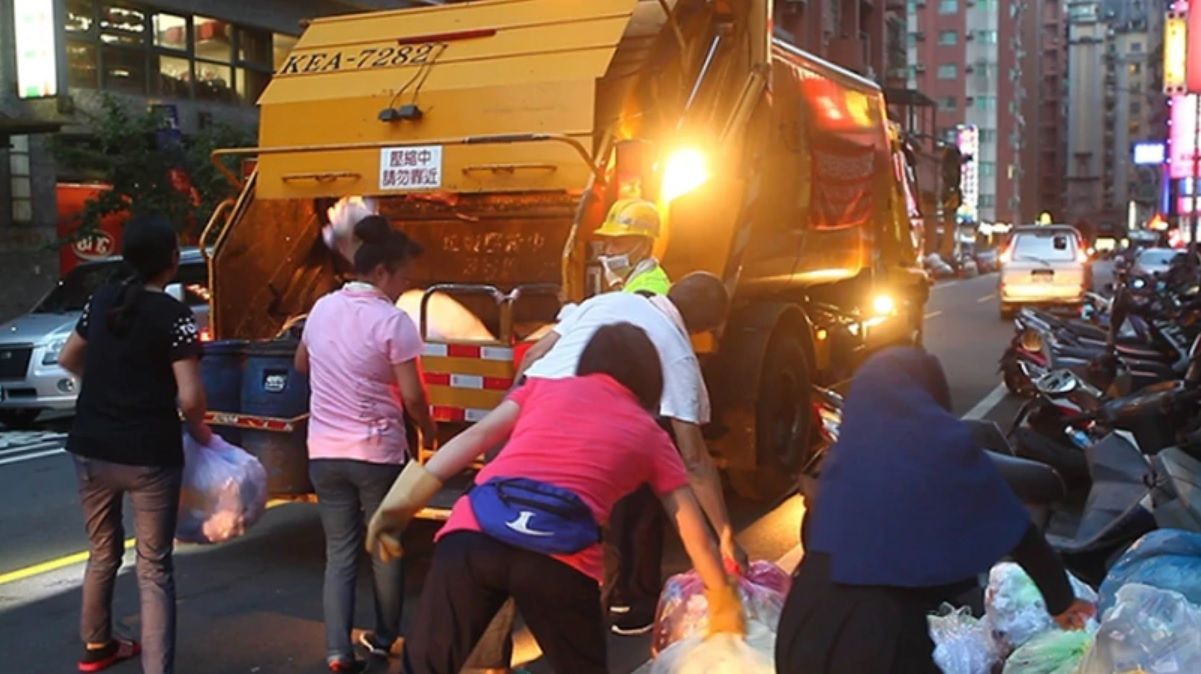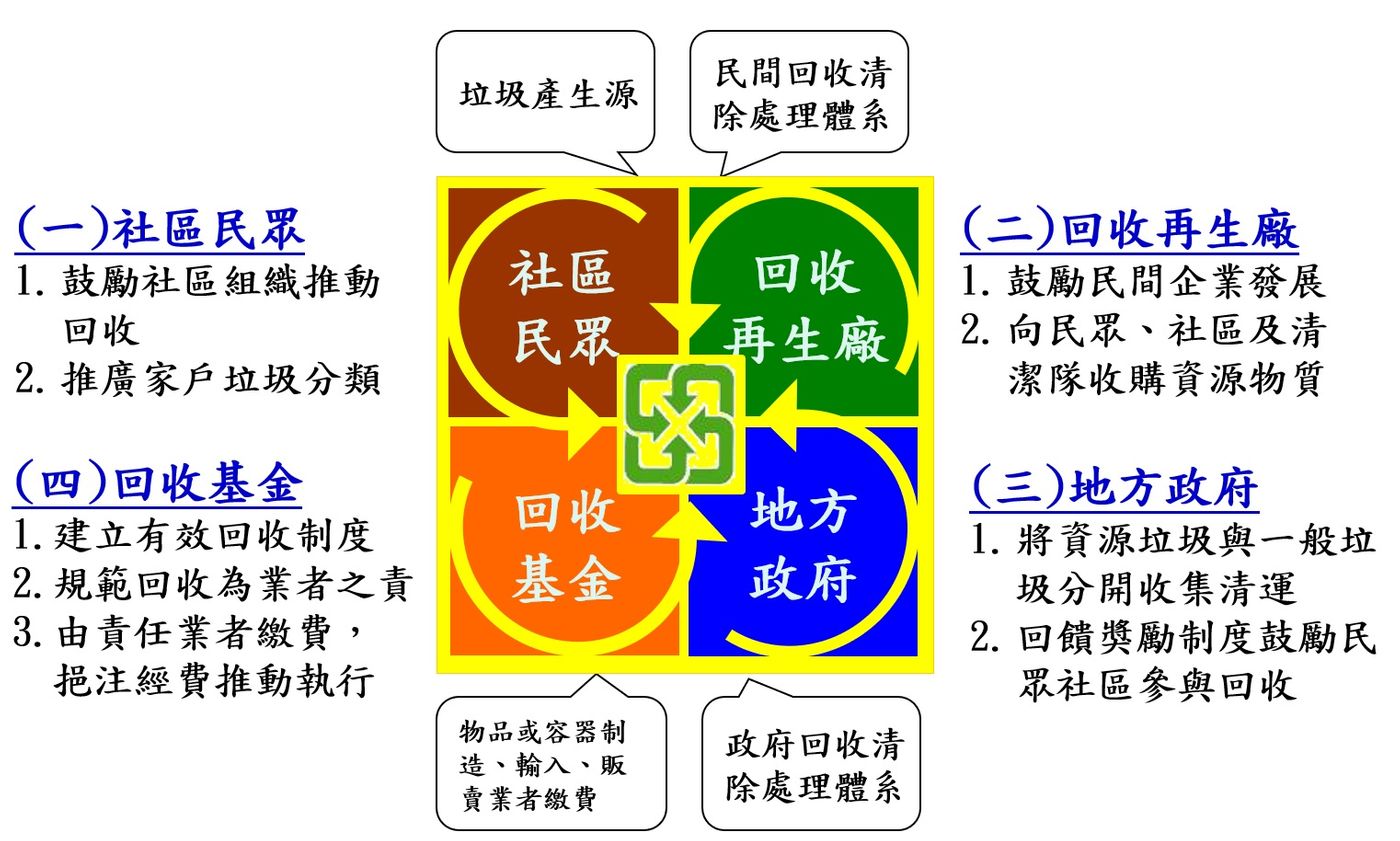History of Taiwan's Waste Policy Changes (Part 1): Policy and Regulatory Framework
Original author: Lai Weijie
This article is a short version, please click here to download and read the full version .

1. Changes in waste management back-end processing policies
Before 1984, Taiwan did not implement a general waste disposal policy, and most waste was disposed of in landfills or piles.
The authorities realized that if they were arbitrarily disposed of by local governments, all the river depressions in Taiwan would be seriously polluted by garbage in the future. Therefore, in 1984, the "Urban Garbage Disposal Plan" was promulgated, which began to plan sanitary landfills in various townships, towns and cities.
However, the location of the burial site is inconvenient due to the narrow land and dense population. In the 1990s, as the capacity of landfills was approaching the upper limit, many townships had nowhere to dispose of garbage, resulting in the appearance of garbage dumping on the streets. In addition, the odor and infectious diseases caused by sanitary landfills have also caused many public complaints. Therefore, in 1991, the government changed to a treatment strategy of incineration as the mainstay and burial as a supplement, and planned the "One incinerator policy for one county and city"; Private investment to build 15 incinerators in a public-run private (BOT) manner. During the construction of the incinerator, apart from the secondary pollution (dioxin, ash containing heavy metals) that people have paid attention to, from a social perspective, its site selection conflicts, lack of public participation, lack of transparency in entry control, and BOT Factors such as the guaranteed waste disposal fee and disposal volume have caused great conflicts and disputes in the society.
Although incinerators are officially packaged in the name of "resource recycling plants", and Taipei City even promoted the "collection of garbage fees with the bag" in 2000, creating a new thinking in Taiwan's waste policy, but overall, incineration was still discarded at that time. core policy of the material policy.
Until 2003, under the pressure of environmental groups and the Legislative Yuan, the EPD launched the "Review and Prospect of Waste Disposal Plan" to examine the lack of the original policy and add the management thinking of "zero waste".
In 2005, mandatory waste classification was implemented. In 2006, kitchen waste recycling was fully implemented, and the construction and operation plans of 11 incinerators were successively cancelled. The axis of Taiwan's waste management policy was reversed.
2. Changes in the front-end treatment policy of waste management - cost and resource recovery
The logic of capitalism in dealing with "garbage": one is that users pay (the facilities are very expensive), and the other is to make it an "industry" (recycling industry, garbage disposal industry). The same goes for Taiwan.
In 1991, the government began to promote the legalization of waste charging, explicitly including cost projects and calculation formulas, and then adjust the burden ratio according to the reality. At the beginning, it was levied at 30% of the cleaning cost, and then the proportion of the reflected cost was increased year by year, and finally reached 100%.
The "General Waste Removal and Disposal Fee Collection Method" stipulates that there are two types of garbage collection methods: one is to calculate the collection based on the water consumption, and the other is to calculate the collection based on the household quota. For non-tap water supply areas, the collection is based on the household registration information.
At that time, for the convenience of administrative operations, the garbage fee was basically levied along with the water fee. It was not until 1997 that the law was amended to add the method of "collection by volume", which provided a legal basis for Taipei City to implement "collection of garbage fees with bags" later.
The legal source for general waste disposal in Taiwan is the Waste Disposal Law. After the amendment of the law in 1988, the management policy design and legal source design of responsible recyclables (wastes that should be recycled) began to exist. Wastes are "necessary for recycling", and the responsibility lies not with consumers, but with producers (enterprises). This is a very important legislative concept and subject. Therefore, all system designs must be undertaken by enterprises and do their best to make consumers willing to recycle, whether it is emotional, enticing or other better planning .
Later, after different institutional designs and policy changes, the resource recovery system gradually became a circular economy industry within the original waste scavenging system.
In 1997, the "Waste Disposal Law" was amended again, stipulating that relevant manufacturers and importers should pay 100% of the "recycling and disposal fee" according to the approved rate, and established a "resource recovery fund", which was included in the entire government budget and accepted the direct supervision of Congress. , and the Environmental Protection Agency established the "Resource Recovery Management Fund Management Committee", referred to as the "Foundation Management Committee".
Manufacturers, importers, and sellers of articles and containers must first declare the business volume and pay processing fees at the rates announced by the government. On the other hand, resource recycling has formed a specialized system in Taiwan. Recycling participants, including the most grassroots, can receive subsidies from the "Foundation Management Committee" after being audited and certified.
There are also two committees established: one is called the "rate review committee", which is dedicated to reviewing the rate of each item that should be recovered; the other is called the "audit certification impartial group selection committee", which is responsible for selecting a non-governmental professional team to do Subsidized audit certification work.

These two committees, together with the Foundation Management Committee, involve huge economic and industrial interests, and also affect the professionalism of the assessment of the environmental impact of product production, distribution, and recycling, as well as the fairness of policy tools. Therefore, the committee includes representatives of various stakeholders, including representatives of environmental protection NGOs - in a transparent manner to reduce all doubts.
Under the recycling fund system, the economic incentives for the entire recycling industry are clear. Since January 1997, the government has promoted the “Resource Recycling Four-in-One Project”, mainly by “community people” through household garbage sorting, various small resource items produced by themselves, combined with “local government cleaning teams”, The power of "Recyclers" and "Recycling Funds" is recycled and reused. Through the integration of these four, a complete recycling network can be established to ensure that resource items are indeed recycled or properly disposed of, and the participating citizens, cleaning teams and recyclers can obtain reasonable profits or rewards to ensure a complete cycle of the recycling system.
Please refer to the image below:

3. Local self-governance: the "political" history of Taipei City's "garbage fee collection"
In the process of changing Taiwan's waste policy, local governments began to propose different visions and pilot plans, which were very important experiences and later became an important driving force for policy changes across the country. Among them, Taipei City took the lead in implementing the "garbage fee collection with bags" policy, which is the most famous and far-reaching.
In the past, the garbage fee was levied along with the water fee, which minimized the government's administrative cost of charging, but it was not fair to those who save consumption, reduce quantity at the source, and recycle resources.
In the beginning, this measure in Taipei was only implemented in a few places on a trial basis. People in the pilot areas have sufficient time to familiarize themselves with the new charging system. The pilot program is roughly divided into three phases: April is the "advocacy period", May is the "persuasion period", and June is the "implementation period".
During the trial period, the administrative department will track the effectiveness of the implementation, and count the amount of waste generated and recycled in the trial area and adjacent areas, so as to know whether the policy really has the effect of promoting waste reduction and resource recovery. In addition, in order to understand whether the situation of littering will be aggravated, the administrative department will also observe the amount of garbage in the roadside fruit peel boxes, the number of littering bags and the cleanliness of the environment in the pilot area.
Citizens in the pilot area gradually realized that the new policy is more fair than the previous collection of water charges, and began to pay attention to resource recycling so that they can spend less money on garbage bags.
However, due to political wrangling, some politicians claimed that "collection from the bag" had no legal basis in order to curry favor with voters, and even pushed the "1998 annual garbage fee to be free" in parliament, which led to the suspension of the entire pilot program. The sequelae immediately appeared: because the garbage fee was waived, private operators who had previously cleared and transported huge amounts of garbage, such as markets and restaurants, terminated their contracts; a large amount of toxic and non-toxic waste was mixed;
But after the general election, Taipei City changed its party in 1999 (the Kuomintang Ma Ying-jeou was the mayor), and the council demanded that the city government must "continue to promote the collection of garbage fees with bags within a time limit." In April 2000, Taipei City promulgated the "Taipei City General Waste Removal and Disposal Fee Collection Autonomy Regulations", which was fully implemented in the city in July, thus establishing a legal source.
The next episode will introduce to you how the people of Taiwan can participate in the reform from the bottom up and promote resource recycling.
Like my work? Don't forget to support and clap, let me know that you are with me on the road of creation. Keep this enthusiasm together!

- Author
- More